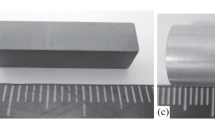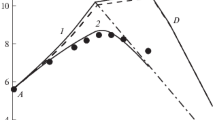Abstract
This article gives a brief review of the main drawbacks of industrial pyrotechnic decelerators produced in different countries. The basic requirements for pyrotechnic decelerators to develop the mining industry and improve portable explosion-jet complexes have been substantiated. As a result of studies, new inhibiting pyrotechnic compositions with a high stability of operating performance and physicochemical properties have been developed. Critical conditions of the onset of stable combustion of new pyrotechnic compositions have been established. The dependence of changes in temperature of reaction products on the combustion rate of the designed compositions and the conditions for subsequent transfer of their combustion to detonation of explosive systems have been established. Recommendations for the component content of the developed compositions and the reduction of their unit cost have been made. In addition, recommendations for the optimization of mass–dimensional characteristics of the means of initiation on the basis of the developed inhibiting pyrotechnic compositions for various conditions of their application and storage have been made.
Similar content being viewed by others
References
Solov’ev, V.O., Kutuzov, B.N., and Orlov, Yu.N., The way to create compact explosion-reaction complex and fields of its application, Gorn. Zh., 2008, no. 5, pp. 50–53.
Soloviev, V.O. and Shvedov, I.M., Movable explosion-reaction complexes for exploring the Far East, Probl. Mashinostr. Avtomatiz., 2013, no. 3, pp. 139–144.
Solov’ev, V.O., Kelner, M.S., and Korovkin, Yu.V., Compact systems of electrical initiation for controlled explosion rocks drilling under complicated conditions, Probl. Mashinostr. Avtomatiz., 2013, no. 1, pp. 106–116.
Solov’ev, V.O., RF Patent 2070708 IPC 6 F 42 B 3/10, Izobret. Polezn. Modeli, 1996, no. 35.
Solov’ev, V.O., RF Patent 2230053 IPC 7 C 06 B 33/00, 33/12, Izobret. Polezn. Modeli, 2004, no. 16.
USA Patent 2478918, 30.11.45.
German Patent 2416920 IPC 5 C 06 B 33/00, 08.04.1974.
Sweden Patent 81032088 IPC 5 C 06 B 33/00, 18.08.1986.
TU (Technical Requirements) no. 212-001-49534204-2003: A, B, C Amorphous Boron Grades, 2003.
Rabinovich, V.A. and Khavin, Z.Ya., Kratkii khimicheskii spravochnik (Brief Chemical Handbook), Leningrad: Khimiya, 1977.
Karapet’yants, M.Kh. and Drakin, S.I., Obshchaya i neorganicheskaya khimiya (General and Inorganic Chemistry), Moscow: Khimiya, 1994.
Kamenetskaya, D.S., Piletskaya, I.B., and Shiryaev, V.I., Zhelezo vysokoy stepeni chistoty (High-Purity Iron), Moscow: Metallurgiya, 1978.
Khimicheskya entsiklopediya (Chemical Encyclopedia), Knunyants, I.L., Ed., Moscow: Soviet encyclopedia, 1988, vol. 1.
Lidin, R.A. et al., Khimicheskie svoystva nneorganicheskikh veshghestv. Uchebnoe posobie dlya VUZov (Chemical Properties of Inorganic Substances. Student’s Book for High School), Moscow. Khimiya, 2000.
Spravochnik khimika (Handbook for Chemists), Nikolskii, B.P. et al., Eds., Leningrad: Khimiya, 1971, vol. 2.
Spravochnik khimika (Handbook for Chemists), Leningrad–Moscow: Khimiya, 1966, vol. 5.
Samsonov, G.V., Serebryakova, T.I., and Neronov, V.A., Boridy (Borides), Moscow: Atomizdat, 1975.
Hansen, M. and Anderko, K., Constitution of Binary Alloys, New York: McGraw-Hill, 1958.
Portnoi, K.I. and Samsonov, G.V., Boridnie splavy (Boride Alloys), Moscow: VINITI, 1959.
Povolotskii, D.Ya., Roshchin, V.E., Ryss, M.A., et al., Elektrometallurgiya stali i ferrosplavov (Electrometallurgy of Steel and Ferroalloys), Moscow: Metallurgiya, 1974.
Schenck, H., Nacken, M., Butenuth, E., and Potthast, E., Forschungsber, Landes Nordrhein-Westfalen, 1966, no. 1589.
Michel, A., Bull. Soc. Chim. France, 1961, no. 1, pp. 143–148.
Tsuzuki, A., Sago, S., Hirano, S.-I., and Naka, S., J. Mater. Sci., 1984, vol. 19, no. 8, pp. 2513–2518.
Perminov, V.P. and Neronov, V.A., Materialovedenie i tekhnologiya materialov (Materials Science and Materials Technology), Novosibirsk: Siberian State Univ. of Geosystem and Technology, 2007.
Gurevich, S.E., Fatigue strength of high-strength steel, Izv. Akad. Nauk SSSR, Met., 1965, no. 4, pp. 126–130.
Spravochnik: svoistva, poluchenie i primenenie tugoplavkikh soedinenii (Properties, Production and Application of High-Melting Compounds. Handbook), Kosolapov, T.Ya., Ed., Mosocw; Metallurgiya, 1986.
Bates, S.E. et al., Synthesis of titanium boride (TiB)2 nanocrystallites by solution-phase processing, J. Mater. Res., 1995, vol. 10, p. 2599.
Hwang, A.Y. and Lee, J.K., Preparation of TiB2 powders by mechanical alloying, Mater. Lett., 2002, vol. 54, no. 1.
Gu, Y. et al., A mild solvothermal route to nanocrystalline titanium diboride, J. Alloys Compounds, 2003, vol. 352, no. 325.
Luchinskii, G.P., Khimiya titana (Chemistry of Titanium), Moscow: Khimiya, 1971.
Shakhno, I.V., Shevtsova, Z.N., Fedorov, P.I., and Korovin, S.S., Khimiya i tekhnologiya redkikh i rasseyannykh elemrentov (Chemistry and Technology of Rare and Scattered Elements), Bolshakov, K.A., Ed., Moscow: Vysshaya shkola, 1976.
TU (Technical Requirement) no. 84 07513406-036-94: Waveguide, 1994.
Author information
Authors and Affiliations
Corresponding authors
Additional information
Original Russian Text © V.O. Solov’ev, V.V. Patsyuk, E.A. Klochko, 2015, published in Problemy mashinostroeniya i avtomatizatsyi, 2014, No. 1, pp. 136–142.
About this article
Cite this article
Solov’ev, V.O., Patsyuk, V.V. & Klochko, E.A. Inhibiting pyrotechnic compositions for new means of initiation. J. Mach. Manuf. Reliab. 44, 609–615 (2015). https://doi.org/10.3103/S1052618815070146
Published:
Issue Date:
DOI: https://doi.org/10.3103/S1052618815070146




